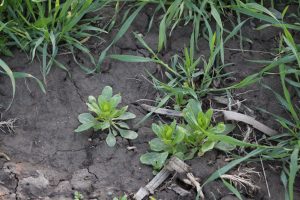Weed Management Considerations (part 1)
By Dusty Sonnenberg, CCA, Ohio Field Leader, a project of the Ohio Soybean Council and soybean check-off.
Weed control in soybeans and herbicide trials have been the subject of research conducted in the Becks Practical Farm Research (PFR) the last several years. “In a time period when there are concerns of herbicide availability, in particular the post herbicides for the coming year, it is important to revert back to what we know works,” said Luke Schulte, Field Agronomist for Becks.

“Understanding how weeds impact yields helps us better understand how we need to plan our herbicide program,” said Schulte. “The true cost of weed control is important to understand in light of higher commodity prices and higher input costs. Yield is a key variable as we try to determine what weed pressure really costs.”
The University of Guelph in Ontario Canada has been conducting weed research for a number of years in a slightly different manner. “The University of Guelph operated on the premise that if weeds and weed resistance are going to evolve faster than new herbicides are being approved, then a new approach may need to be taken,” said Schulte. “They looked to see if different soybean varieties responded differently to various levels of weed pressure. They also studied the impacts of weed competition in nutrients, water, and sunlight.”
In a greenhouse project, university researchers grew soybeans and weeds in individual pots placed closely together but in separate containers. In this way there was no competition for water or nutrients. The goal was to study the light waves received by the plant. “Plants absorb a lot of different wave lengths,” said Schulte. “Plants prefer red and blue light. What the researchers found was that the plants did not like the far-red light that is reflected off the leaves of the weeds. That far red light was causing stress in the form of free radicles to be produced in the crops. The closer the weed pots were to the plants, the more free radicles were produced in the plants, causing stress and an energy imbalance physiologically. This appearance is similar to what occurs in drought stress or wet weather stress to a plant. The plants that were more stressed in this study had fewer root hair and soybeans did not nodulate as quickly, also photosynthesis was delayed. When the weeds were removed, the stressed plants responded, but did not catch-up 100% with the plants not in the presence of the weeds.” (In the corn study the researchers were able to break down the yield reduction from delayed weed control to what it cost per hour until the weeds were removed, and what the yield reduction was per day until the weeds were removed.)
“This research explains the invisible yield loss, even when the plants were provided with sunlight, moisture and nutrients without direct competition,” said Schulte. “Weed control in the past has been reactionary, especially with resistance concerns. We would apply a pre-emerge, and then follow up with a post with the goal of controlling the weeds we see. The process was reactionary to reduce competition. We need to look at weed control in a different way from the past now that we understand how yield is being reduced.”